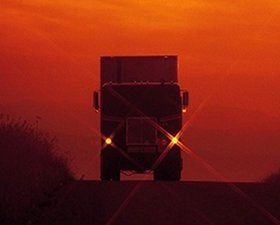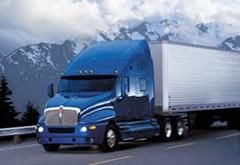Question: Why Do Companies Choose The Trucks They Choose?
Topic 20080 | Page 1
I think the variety demonstrates how evenly matched most trucks are today. Otherwise you're right, if there was a large disparity in cost, fuel mileage, or driver preference you would see certain brands dominating the landscape.
I also think that over the years you're seeing the major manufacturers mimicking each other more and more. Look at trucks 30 years ago and there was a much bigger difference in design. Today they all have a very similar shape and structure, both inside and out. Peterbilt is the best example of that. They were going to get crushed if they weren't able to provide a truck that the large fleets would use and these days they have their generic 'fleet version' like everyone does.
Design has moved away from differentiation and toward efficiency. There simply aren't many options for design when airflow needs to be efficient, and there aren't many options for engines when emission control is tight.

Speaking of air flow, I've wondered about the volvo design. The squared look, as opposed to the rounded look that most others use. I like the look of the volvo, but wondered how aerodynamic it is with those hard edges. I asked someone once and was told that the volvo design is one if the most aerodynamic trucks on the road.
Is this factual?
HOS:
Hours Of Service
HOS refers to the logbook hours of service regulations.The new Cascadia has added some sharp corners. Also the Western Star 5700 has a few sharp corners as well.
A lot has to do with finance and "relationships" also.
Volvo, years ago - had a really bad parts supply chain - dealers weren't open on weekends, etc. As nice as they were/are, if you can't get your trucks fixed when they go down, you buy someone else's. They've since way improved their act.
Freightie has always been the major in the vertical market, both in marketing and support.
The "hearts and minds" of trucking companies - are attracted to PRICE first. And buying 100's of units a year sweeten their negotiating position. Fuel efficiency and MTBF (Mean Time Between Failures) are important, as is parts/service availability. Freightliner has always led the way, due to market saturation and pricing flexibility.
Driver comfort/preference also rates highly on the totem pole - but not nearly as much as financial aspects.
Most larger companies turn over their fleets pretty quickly. O/O's may keep their trucks for 7-10 years (or more), companies dump them in 3 (typically).
A lot has to do with the business model. A few of the large companies, have leasing companies also. They buy (or lease) the trucks, lease them to the company (or driver) - which is a better write-off for the company, then re-sell them when they "age out" of serviceability. For many companies, the leasing and sales of their trucks, are as great a profit center, as the transport side of the business.
So it's more about $$ than anything else (it IS a business after all).
Rick
The trucks purchased by our company has more to do with the particular dealer relationship with our company's owner, who gives the best price, and which brand can fulfill the order at the time we need it.
Currently they're wooing him, sending over all these high end fancy trucks for him to "try out". A few long time drivers have also been taking them for a spin and an evaluation.
In my local tanker company we mostly use Peterbilts and some KWs. They buy the Petes and lease the KWs.
The owner is a 45+ year trucking veteran and he believes that Freightliners and Internationals are not heavy duty enough to withstand the beating. We do a lot of mountains in the middle of no where (talking 6-12% grades easily unmarked), constant stopping and starting, and lots of 80k+ GVW.
His company, his trucks. Doesn't make a difference to me. Though I do enjoy driving my flat nose Pete with Cummins over the Freightliners I used to drive OTR.
OTR:
Over The Road
OTR driving normally means you'll be hauling freight to various customers throughout your company's hauling region. It often entails being gone from home for two to three weeks at a time.

Though I do enjoy driving my flat nose Pete with Cummins over the Freightliners I used to drive OTR.
Sure, go ahead and rub it in.
OTR:
Over The Road
OTR driving normally means you'll be hauling freight to various customers throughout your company's hauling region. It often entails being gone from home for two to three weeks at a time.

It's probably also worth noting that trucks vary considerably. If you want, say, a Freightliner Cascadia, it's considerably more involved than just stopping by the Freightliner dealer and saying, "one Cascadia, please." Essentially the differences in trucks can come down to little more than the shell they decide to put over the engine and chassis.
If you look at any truck stop, though, you'll see that there is a dominant big dog there, and it's the Cascadia. While you can get a whole bunch of specs like any truck, as folks have mentioned Cascadia's tend to have the biggest bang for their buck. I know England has tested other trucks, primarily the Western Star's you see running around somewhat frequently, but we're back to going all Cascadia now because the WS's were going down way too frequently.
That is funny you mention Western Stars going down more frequently than the Freightliner. Other than the cosmetics, pretty much same truck! Daimler owns both. I good comparison ,using another company that Daimler used to own, is Chrysler. Freightliners are the Dodges and Western Star are the Chryslers. I guess you could say Sterling is the Plymouth. Both lines are discontinued.
You have the exact same availability of engines and transmissions choices for Western Stars and Freightliners. That is why every Freightliner service point is also a Western Star service center.
Volvo and Mack are both own by the same company.
Peterbuilt and Kenworth are both owned by the same company.
International are kinda the only one that stands alone of the class 8 truck manufacturers.
New Reply:
New! Check out our help videos for a better understanding of our forum features

















Preview:








 TT On Facebook
TT On Facebook
You have various companies all driving different equipment. Knight uses volvo, freightliner, and international. Swift uses KW and freightliner mostly. Werner uses mostly KW.
I guess the question is, surely there have been many studies, reports and tests that would show that certain brands offer the best fuel economy and efficiency for the best price.
Most companies are looking for the best deal to get the most efficient equipment, so you'd think they would all be using mostly the same equipment.
I'm sure some companies get better deals on new trucks from certain manufacturers, but then surely that manufacturer would be able to offer the same deal to all companies, in order to sell higher quantities of trucks.
I guess what I'm saying is, if the studies show you can get the best bang for the buck with brand X, then why would a company use brands Y and Z instead?
I know it would be quite boring if everyone all used the same equipment, but in business, it's all about the bottom dollar and getting value for your money.